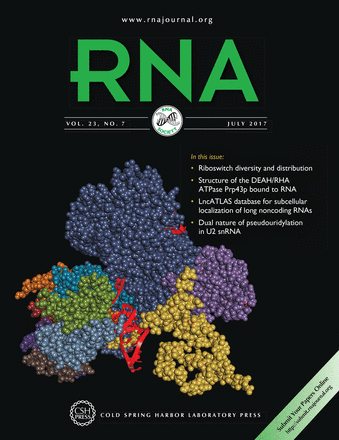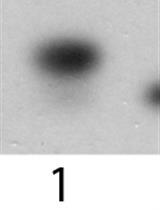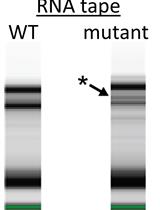- EN - English
- CN - 中文
Purification of RNA Mango Tagged Native RNA-protein Complexes from Cellular Extracts Using TO1-Desthiobiotin Fluorophore Ligand
使用TO1-脱硫生物素荧光团配体从细胞提取物中纯化RNA Mango标记的天然RNA-蛋白质复合物
发布: 2018年04月05日第8卷第7期 DOI: 10.21769/BioProtoc.2799 浏览次数: 8704
评审: Gal HaimovichAnca SavulescuAnonymous reviewer(s)

相关实验方案
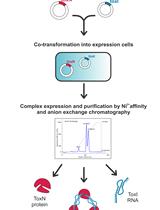
从大肠杆菌中大规模纯化III型毒素-抗毒素核糖蛋白复合物及其成分,用于生物物理学研究
Parthasarathy Manikandan [...] Mahavir Singh
2023年07月05日 2111 阅读
Abstract
A native purification strategy using RNA Mango for RNA based purification of RNA-protein complexes is described. The RNA Mango aptamer is first genetically engineered into the RNA of interest. RNA Mango containing complexes obtained from cleared cellular native extracts are then immobilized onto TO1-Desthiobiotin saturated streptavidin agarose beads. The beads are washed to remove non-specific complexes and then the RNA Mango containing complexes are eluted by the addition of free biotin to the beads. Since the eluted complexes are native and fluorescent, a second purification step such as size exclusion chromatography can easily be added and the purified complexes tracked by monitoring fluorescence. The high purity native complexes resulting from this two-step purification strategy can be then used for further biochemical characterization.
Keywords: RNA Mango (RNA Mango)Background
Current RNA tags suffer from limitations such as poor KD, large size, potential biological interference or lack of intrinsic fluorescence (Panchapakesan et al., 2015). RNA Mango is small, can be simply integrated into stem-loop structures, in particular, GNRA tetraloops, is biologically tolerated and above all has a high affinity for its thiazole orange-based (TO1) ligand, TO1-Desthiobiotin (TO1-Dtb). This allows Mango tagged complexes to be easily bound and washed on streptavidin beads (summarized in Figure 1). The Mango:TO1-Desthiobiotin complex is highly fluorescent and can be eluted from streptavidin beads by the addition of biotin. The fluorescence of Mango tagged native complexes allows additional purification steps to be used to obtain highly purified native complexes. 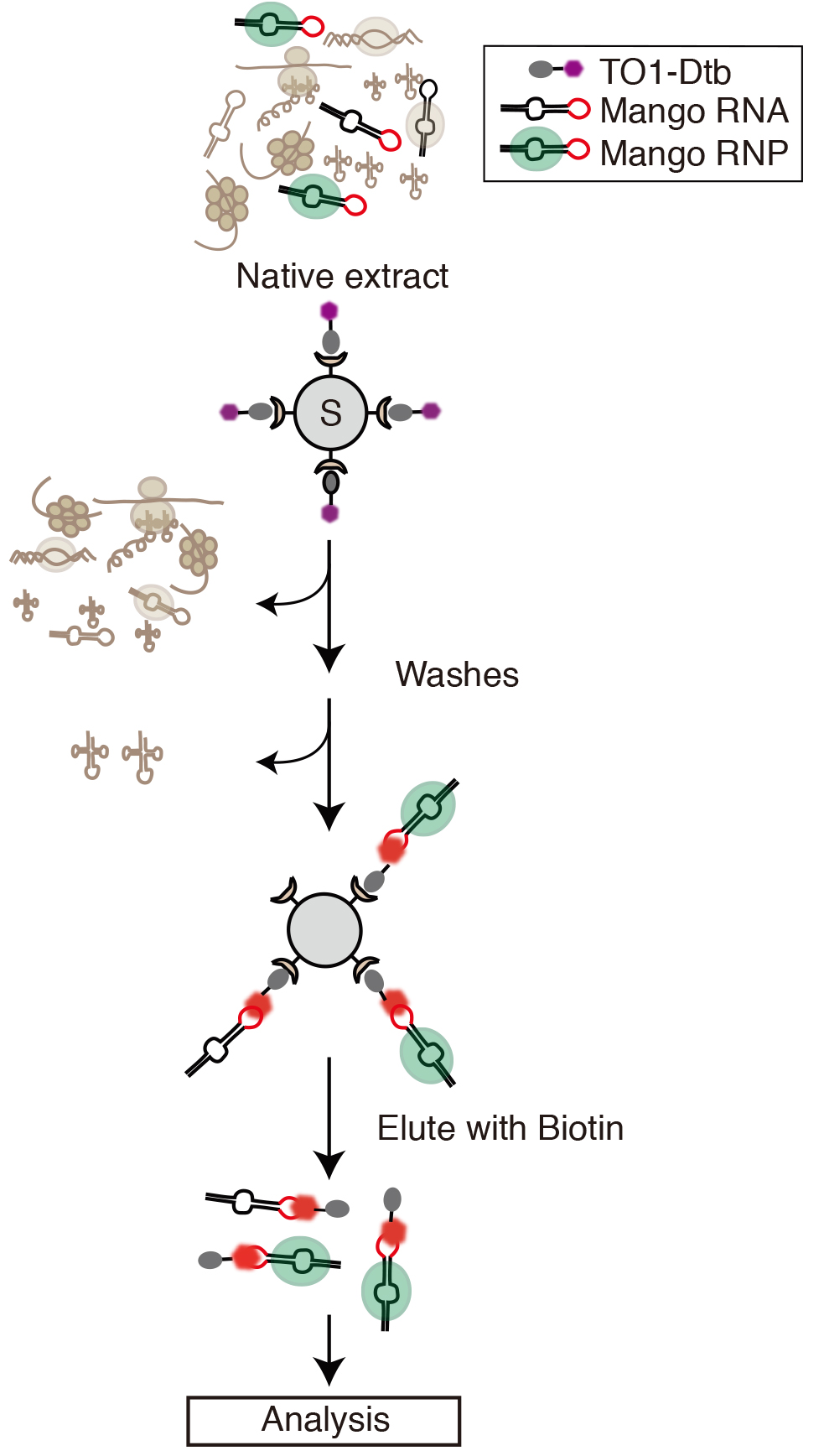
Figure 1. Purification of Mango tagged RNA-protein complexes out of native extract. RNA constructs are designed (Procedure A, Figure 2) so that the Mango tag is located in a biologically compatible location. After bacterial expression of this construct, a native extract containing the Mango tagged RNA (Mango tag shown in red highlight), is prepared (Procedure B). Mango tagged RNA and RNA complexes are then bound to streptavidin beads (Black circle containing S) that have been derivatized with TO1-Desthiobiotin (Dtb, Procedure C). The thiazole orange moiety of TO1-Dbt is shown in purple and becomes highly fluorescent once bound by Mango (bright red highlight). Bound complexes are then extensively washed in native conditions (Procedure D). After washing fluorescent Mango tagged complexes can be eluted in native conditions by addition of biotin (Procedure E). Downstream analysis including further purification steps can then be simply implemented (Procedures F and G).
Materials and Reagents
- Low retention pipette tips (Fisher Scientific, catalog numbers: 02-717-134 , 02-717-143 , 02-707-511 )
- Microcentrifuge tubes, pre-lubricated (Corning, Costar®, catalog numbers: 3206 , 3207 )
- 96-well black wall, clear bottom, non-binding, non-sterile, Greiner Bio-One microtiter plate (Greiner Bio One International, catalog number: 655906 )
- Tricorn XK 16/40 SEC column (GE Healthcare, catalog number: 28988938 )
- Bacterial cells (E. coli) with RNA Mango tagged RNA of interest
- Liquid nitrogen
- TO1-PEG3-Desthiobiotin (ABM, catalog number: G956 )
- High capacity streptavidin agarose beads (Thermo Fisher Scientific, Thermo ScientificTM, catalog number: 20357 )
- Superdex 200 resin (GE Healthcare, catalog number: 17104301 )
- SYBR Green II RNA Gel Stain (Thermo Fisher Scientific, InvitrogenTM, catalog number: S7564 )
- 19:1 Acrylamide:Bis 40% (Thermo Fisher Scientific, catalog number: AM9022 )
- N,N,N’,N’-Tetramethylethylenediamine (TEMED) (Sigma-Aldrich, catalog number: T9281 )
- Ammonium persulphate (APS) (Bio-Rad Laboratories, catalog number: 1610700 )
- Boric acid (ACP Chemicals, catalog number: B2940 )
- EDTA (ACP Chemicals, catalog number: E4320 )
- Tris base (Fisher Scientific, catalog number: BP152 )
- Tris-HCl (Sigma-Aldrich, Roche Diagnostics, catalog number: 10812846001 )
- Potassium chloride (KCl) (Sigma-Aldrich, catalog number: P9541 )
- Magnesium chloride (MgCl2) (Sigma-Aldrich, catalog number: M8266 )
- DTT (Sigma-Aldrich, Roche Diagnostics, catalog number: 10197777001 )
- Sodium hydroxide (NaOH) (VWR, BDH, catalog number: BDH9292 )
- Sodium chloride (NaCl) (ACP Chemicals, catalog number: S2830 )
- HEPES (Sigma-Aldrich, catalog number: H3375 )
- Heparin (Sigma-Aldrich, catalog number: H0777-25KU )
- Biotin (Sigma-Aldrich, catalog number: B4501 )
- Yeast extract (Fisher Scientific, catalog number: BP1422 )
- Tryptone (Fisher Scientific, catalog number: BP1421 )
- Potassium hydroxide (KOH) (VWR, BDH, catalog number: BDH9262 )
- 10x Bacterial Native Extract (BNE) buffer (see Recipes)
- 10x Buffer A (see Recipes)
- 10x HEPES KCl (HK) buffer (see Recipes)
- 10x Binding buffer (see Recipes)
- 10x Biotin elution buffer (see Recipes)
- LB media (see Recipes)
Equipment
- Standard personal protective equipment
- Pipettes
- Peristaltic pump
- Fraction collector and appropriate collection tubes
- SpectraMax M5 fluorescent plate reader (Molecular Devices, model: SpectraMax M5 )
- Temperature controlled room (To be maintained at 4 °C)
- Preparative centrifuge, microcentrifuge and benchtop Picofuge
- Tube rotator for 1.5 ml tubes
- Polyacrylamide gel running equipment
- French press
- Sorvall RC6+ centrifuge (Thermo Fisher Scientific, Thermo ScientificTM, model: SorvallTM RC 6 Plus )
- Sorvall SLA-1500 rotor (Thermo Fisher Scientific, Thermo ScientificTM, catalog number: SLA-1500 )
- NanoDrop
- Autoclave
Procedure
文章信息
版权信息
© 2018 The Authors; exclusive licensee Bio-protocol LLC.
如何引用
Panchapakesan, S. S. S., Jeng, S. C. Y. and Unrau, P. J. (2018). Purification of RNA Mango Tagged Native RNA-protein Complexes from Cellular Extracts Using TO1-Desthiobiotin Fluorophore Ligand. Bio-protocol 8(7): e2799. DOI: 10.21769/BioProtoc.2799.
分类
微生物学 > 微生物生物化学 > RNA
生物化学 > RNA > RNA-蛋白质相互作用
您对这篇实验方法有问题吗?
在此处发布您的问题,我们将邀请本文作者来回答。同时,我们会将您的问题发布到Bio-protocol Exchange,以便寻求社区成员的帮助。
Share
Bluesky
X
Copy link


